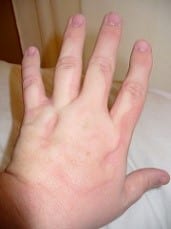What is Cold Urticaria?
Cold urticaria is a condition that affects the skin. It is characterized by the development of reddish, itchy welts (hives) and/or swelling (angioedema) within minutes after skin exposure to cold. This includes cold air temperature, cold water and even cold objects.

Symptoms of Cold Urticaria
The severity of symptoms can vary greatly from person to person. Some may have minor reactions, while others may experience a more severe type of reaction, called anaphylaxis, upon cold exposure. Generally, the severe reactions occur with full skin exposure to the cold, such as when swimming in cold water. Cold urticaria occurs most frequently in young adults.
Signs may include the following:
- Hives on the areas of the skin that have been exposed to cold
- Swelling of the skin with cold exposure. Examples of that would include swelling of the hands while holding a cold object or swelling of the lips after consuming cold food or drink
- Worsening of the reaction as the skin warms
Severe reactions may include:
- Swelling of the tongue and/or throat (causing difficulty breathing)
- Symptoms of anaphylaxis, (a whole-body response) such as swelling of the limbs or torso, wheezing, increased heart rate, shock, and loss of consciousness

Exposure of the skin to damp and windy conditions may make the signs of flares more evident. An episode of cold urticaria may persist for up to two hours. This condition may go away on its own after a short period of time, or it may persist.
Causes of Cold Urticaria
It is unclear what causes cold urticaria. These individuals appear to release mediators from their mast cells (histamine and others) with a cold stimulus, with resulting hives or angioedema. This is called primary acquired cold urticaria and most frequently occurs in young adults.
Less commonly, cold urticaria can be caused by an underlying health condition, such as hepatitis or cancer. This is called secondary acquired cold urticaria.
Rarely, cold urticaria is an inherited trait. With this type of hereditary urticaria, symptoms may include painful welts or hives and flu-like symptoms after cold exposure.
Diagnosis and Treatment
If you have experienced potential symptoms of cold urticaria, make an appointment with one of our physicians. After obtaining a thorough history, specialized skin testing, called an ice cube challenge, may be performed under supervised conditions. Once a diagnosis has been made, potential treatments may include the following:
Medications:
- Antihistamines
- Auto-injectable epinephrine (depending upon your history & severity of symptoms)
Prevention Tips:
- Take meds as prescribed
- Protect skin from cold or sudden changes in temperature
- Swimming Precautions: never swim alone test water temperature first swimming partner should be trained in the use of auto-injectable epinephrine
- Avoid ice cold drinks and food
- If having surgery, notify surgeon regarding your cold urticaria. There are steps that can be taken to help prevent symptoms in the OR.
Although there is no cure for cold urticaria, it can usually be controlled with cold avoidance and antihistamine therapy.